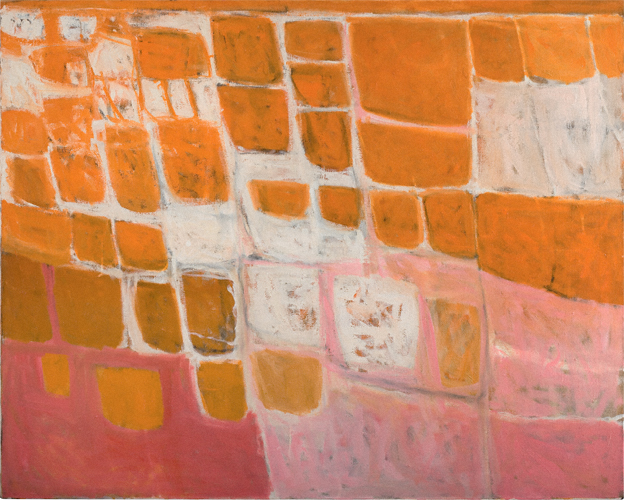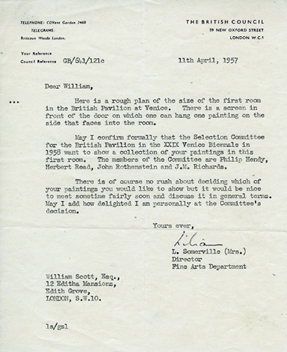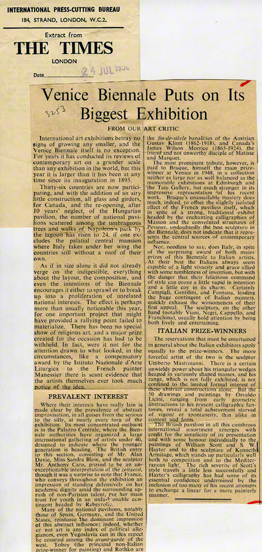Ciao Venezia! William Scott at the 1958 Venice Biennale

Dark-haired gondoliers, sunlight glinting on the water, the graceful curved arches of the Doge’s Palace – just some of the memories of Venice captured in a series of black-and-white photographs in the William Scott Archive. They date to 1958, the year the British Council chose William Scott (along with Kenneth Armitage and William Hayter) to represent Britain at the XXIX Venice Biennale. The photographs, mostly taken by James Scott, William and Mary’s younger son, serve as an atmospheric record of a particular moment in time, of people and places; Ben Nicholson, Lynn Chadwick, Matthew Smith, John Russell, Erica Brausen, Lilian Somerville, Charles Lienhard – are just some of those depicted.
Correspondence and newspaper cuttings in the Archive help to flesh out our understanding of this event in Scott’s career, providing information the photographs cannot. For example, we know that Scott had been notified of his selection the previous year; in a letter from Lilian Somerville (Director of the Fine Arts Department, British Council) dated 11 April 1957 Scott was informed, ‘the Selection Committee for the British Pavilion in the XXIX Venice Biennale in 1958 want to show a collection of your paintings… The members of the Committee are Philip Hendy, Herbert Read, John Rothenstein and J.M. Richards.’ Scott was clearly excited by the news and eager to share it; exactly a month later, a letter from his American dealer Martha Jackson begins, ‘Time has flown like mad since receiving your April letter. Wonderful news about the Venice Biennale. Congratulations! We are all delighted and expect to be on hand.’
The Scotts decided to stay in Venice for the duration of the Biennale, and found an apartment (1063 San Trovaso) to rent behind the Accademia which was large enough to accommodate the couple and their two sons. Importantly, Scott was able to paint in a studio provided for him by the Accademia, where he had the space to work on large size canvases.
According to the reviewer for the Manchester Guardian, the opening of ‘the world’s biggest art fair’ was a damp affair, with ‘Four hundred and fifty art critics and journalists from forty nations, paddling for two days through rivers of a monsoon-like rain from pavilion to pavilion.’ [Sylvia Sprigge, ‘Sculptors Prominent at Venice Biennale: Britain’s Three-man Show’, Manchester Guardian, 16 June 1958] The size of the XXIX Biennale was remarked on by many critics, including the art critic of The Times who reminded his readers that ‘this year it is larger than it has been at any time since its inauguration in 1895. Thirty-six countries are now participating … and the number of national pavilions scattered among the umbrageous trees and walks of Napoleon’s park by the lagoon has risen to 24, if one excludes the palatial central mansion where Italy takes under her wing the countries still without a roof of their own.’ [‘Venice Biennale Puts on Its Biggest Exhibition’, The Times, 24 July 1958]. Scott’s paintings, which were hung in the large square entrance hall of the British Pavilion were generally well received and more than one writer commented on the quality of the pavilion’s presentation. The critic, J.P. Hodin, was struck by signs of a growing momentum towards figuration: ‘England can pride itself on having in Scott and Armitage two of the most serious representatives of this new revival.’[‘A Biennale of Surprises’, Art News and Review, 2 August 1958]
The Scotts, with their son James, left Venice to return to England on 4 September 1958. They visited Palladio’s Teatro Olimpico in Vicenza, before driving through Switzerland to Brussels where they arrived on 9 September in time to visit the World’s Fair, Expo 58. They travelled on to London the following day.
For more information contact:
Lucy Inglis – lucy.inglis@williamscott.org



